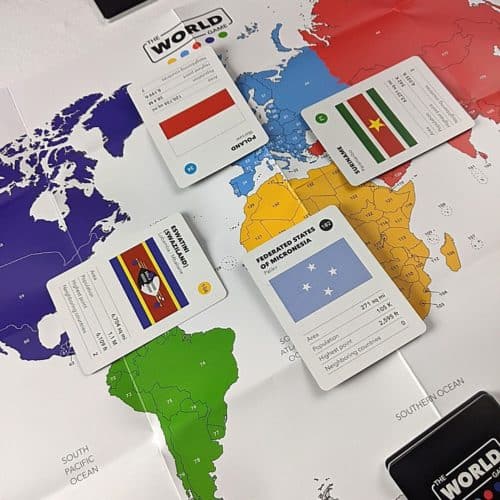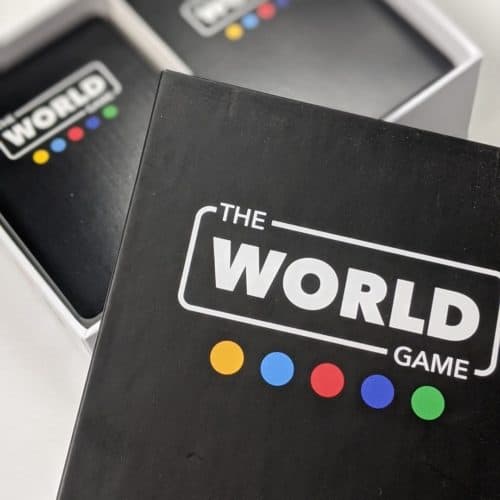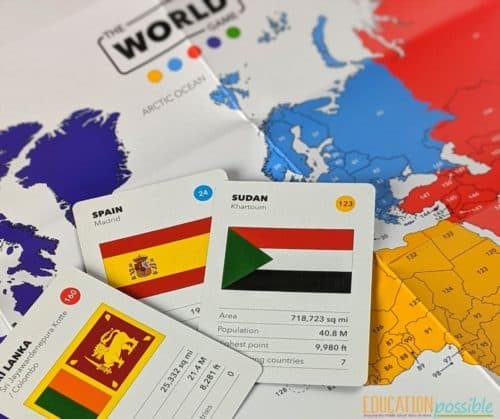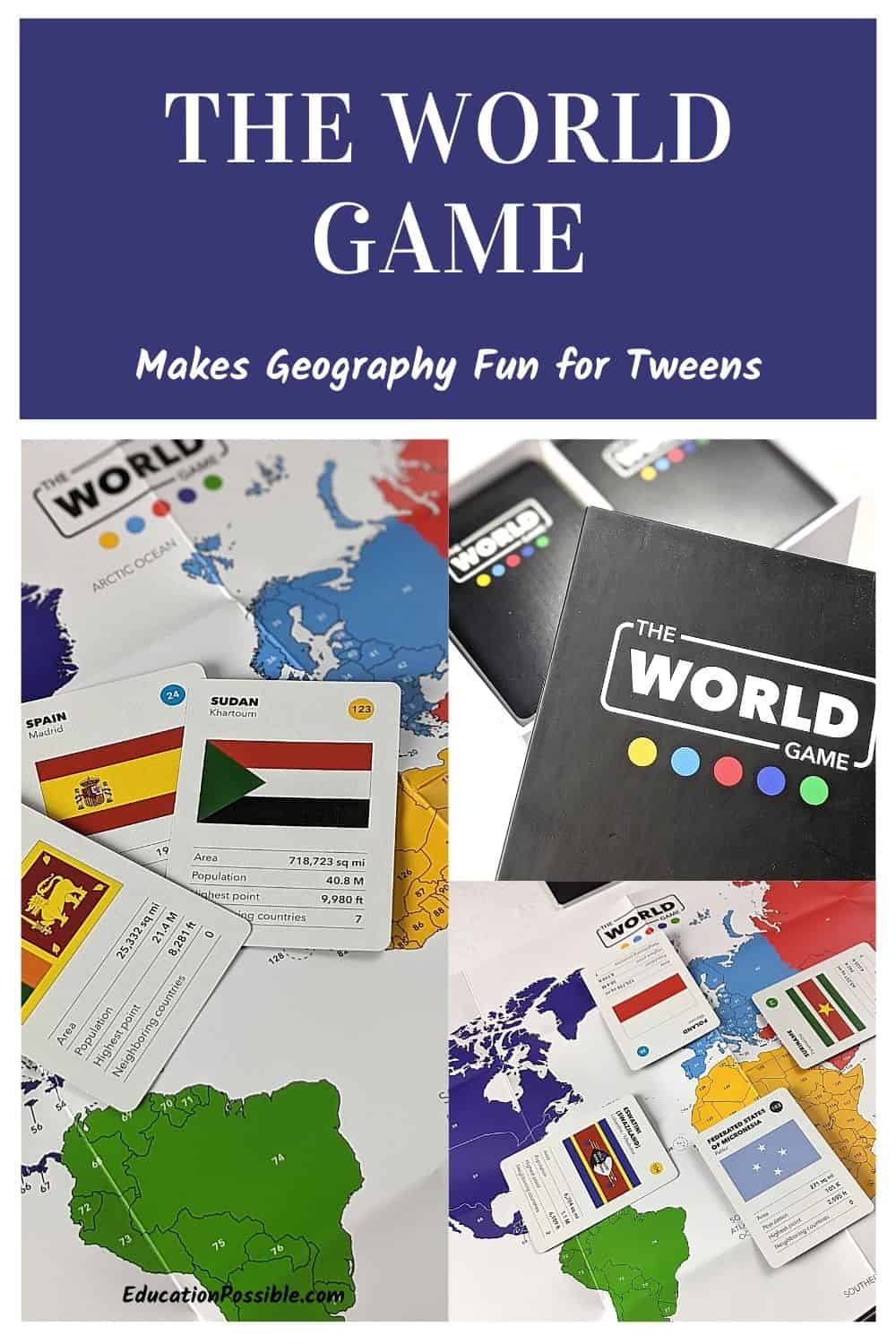Geography Lessons Are More Fun With The World Game
The World Game is an awesome geography card game. It’s one of the many ways you can make middle school geography fun and interactive for your tweens.
While playing, tweens will test their knowledge on various country facts, competing for cards against other players.
The concept is simple, but unless you and your middle schooler are world geography geniuses, there are plenty of challenges involved for everyone.
Any links in this post may be affiliate links. See my disclosure statement.
The World Game Makes Geography Fun for Tweens
This is a fun and interactive way to help your tweens (and you) build geography knowledge. Activities like this are great for teaching geography to middle school students.
The World Game consists of 194 cards, representing the 193 United Nations member states plus Vatican City, and a large folded world map. It comes in a small box, making it easy to travel with.
There is a card for each country. On each one is a flag, four facts about the country, and additional information players can use within the game to challenge each other.
During the game, older kids will interact with world geography including continents, countries, cities, flags, map locations, and more. The more they play, the more they will remember.
Tweens will enjoy challenging their friends and family to see who has the most geography knowledge. It’s a quick game (under 30 minutes) so it’s easy to add to a family game night or homeschool day.
It’s an excellent geography board game.

How to Play The World Geography Card Game
If your tweens have ever played War, they’ll have no problem picking up The World Game – geography card game because the basic premise of the two games is similar.
Start by laying the map on the table. Then, have someone shuffle the cards, and hand out 20 cards to each player. Those cards are kept in a stack, face-up in your hands.
The player to the left of the dealer begins the game by choosing one of two gameplay options by calling out either fact or challenge.
When a Player Chooses Facts
If the player starts the round by calling fact, she’ll choose one of the four facts from the top card in her hand and state it out loud. Everyone else lays their top card onto the map, facing up. The person with the highest value wins the turn.
When choosing which fact to test others on, make sure you choose what you feel is the country’s strongest fact. Make sure you’re using some strategy in your gameplay.
Let’s say Singapore was your top card. You probably wouldn’t choose the neighboring countries fact to challenge everyone since it doesn’t border any. On the other hand, Kenya has five bordering countries, so if this were your card, choosing this fact might be a wise choice.
The winner of the turn picks up all the cards that were just played and puts them at the back of her own deck of cards.
Similar to war, if there is a tie amongst the highest values, those players involved in the tie will put down their next card and the highest one of those will win the turn.
When a Player Chooses Challenge
If a player shouts challenge at the start of a turn, he’ll pick a player who will choose one of these four challenges.
- Continents – the player shares the name of the country on the card at the top of her pile. The rest of the group races to be the first person to name the continent the country is located on.
- Flags – the player shows the flag on the card at the top of his pile, being sure to cover up the country’s name and capital city. Everyone else tries to name the flag’s country.
- Location – the player states the name of the country on the top card in her hands. Players rush to point to the country’s location on the map.
- Capital Cities – the player announces the name of the country at the top of his pile. The rest of the players try to be the first to shout out the name of the capital city.
A correct answer will win you cards, while an incorrect one will cost your card.
Regardless of what option was played, the winner of the turn starts the next round.
The goal is to win everyone else’s cards.

Things to Keep in Mind When Playing The World Game
- When you’re playing a continent challenge, if a country lies on two continents, in order to win the round, a player must correctly name both of them.
- During a capital city challenge, players can name just one city if the country has two.
- Make sure to use some strategy when you’re in control of the round. If you feel that you have a strong fact on your top card, see if others can beat it. If you know your opponents are weak on flag knowledge, throw out a challenge to try to win some cards.
Game Variations You Can Make
The World Game is incredibly flexible. There are a number of things you adapt to fit your group’s needs.
- Instead of letting the winner start the round, go around the table, giving everyone an equal chance.
- Play only facts or challenges during the game, or choose specific challenges for the game. This is good if the people playing are at different expertise levels.
- To make the game easier, players can all share the name of the country at the top of their pile before each turn. The player choosing the fact challenge would have a slight advantage because he would know what everyone else is about to play.
- Give each player more or fewer cards at the beginning.
- Let players go one-on-one for challenges. Instead of everyone participating during a challenge round, it could be between two players.
- Unless everyone is a geography master, consider choosing a continent at the beginning and only play with those cards. As your group builds their knowledge, choose new or more continents to play with.

Using This Geography Game in Your Homeschool
World map games for middle school are easy activities to add to your homeschooling day. While not a substitute for a well-rounded geography curriculum, they’re definitely helpful tools.
Tweens build geography knowledge through repetition. But this can often get boring for them. That’s why The World Game is perfect for geography fact mastery.
As I mentioned, it’s a quick game, so you can easily tack it onto a geography lesson. If you’re studying European countries, pull out the cards for that continent and play a few rounds together. Use it as a tool for learning the flags of the world.
Or, if you have a day that’s a bit lighter, play games like this one to keep the learning going in a different way.
If your tween struggles with geography, spend some time looking over the map and cards before you start to play. Make sure everyone understands the information on the cards and how to use it during the game.
Here are a couple of other ways you can expand your tween’s geography lessons using this game.
- Use the cards to play a version of memory. Choose a bunch of cards representing all of the continents. Lay them out face-down in a grid. Have your kids build matching by finding countries that lie on the same continents.
- Have your tween choose a country from their hand during the game to study further. They can complete activities like filling out a notebooking page, watch a video, take a virtual tour, etc.
- Take the cards from your hand and look up the various languages spoken in the countries.
Educational games like The World Game are fun for tweens, whether you use them in a school setting or they play with their friends. Trust me, they’ll love challenging each other to see who is the geography champion.
It’s a fun way to work on geography and you can rest assured that every time they play, they’ll learn something new.
Additional Educational Game Resources for Tweens
- Many board games for teenagers are able to be used as a fun tool in school.
- Here are a bunch of geography games that will engage your tween.
- Use flags of the world memory to build flag identification skills.
- Play Geography Terms BINGO to help your tween master geography vocabulary.
Must-Have Geography Games for Your Homeschool
- Continent Race Card Game is a fast-paced card game that will help your tween learn more about continents, countries, and flags.
- The Scrambled States of America may seem like a simple card game, but it’s challenging to remember the facts of a state when you’re trying to beat your opponent.
- Travel the world and learn about cultures in the Passport to Culture game.
- See how well your tween knows the Countries of the World.
What excites you most about The World Game?


